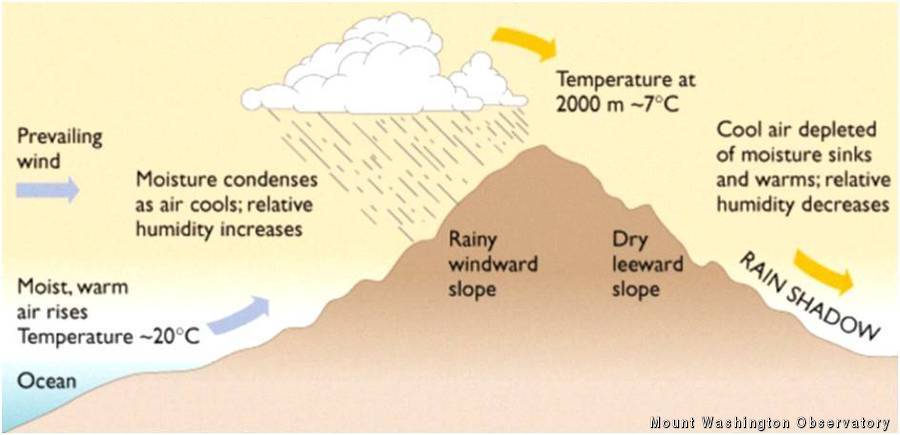October Orographic Uplift
2012-10-01 18:12:12.000 – Brian Fitzgerald, Weather Observer/Education Specialist
Diagram of Orographic Uplift
Happy October! It was quite the surprise to wake up to a blanketed-white summit and snow flakes flying. While a slight chance for mixed precipitation showers were in the forecast for today, it’s always a pleasant surprise when you wake up to a new day and month.
The white stuff made a transition to rain by late in the morning as low pressure moved offshore, though not quite taking all the rain with it. As most of the rain in the region tapered off, steady light rain showers refused to leave the radar over the White Mountains, and more specifically right over our station, leading at least one observer to make the comment, ‘Ah, upslope showers.’ What is an upslope shower though? Certainly in my time as a hiker, intern and observer I’ve heard the term upslope showers being thrown around and wondered why Mount Washington was plagued by this.
Essentially, when we talk about upslope showers, we’re talking about precipitation that is being formed by the size and shape of the mountain itself. Mount Washington is not the only mountain in the world that experiences this effect, but nearly every topographically-prominent mountain contributes to something known as orographic lift. When moisture-rich air is pushed into and up the side of a mountain it cools and condenses into clouds and eventually falls as precipitation on the windward side of the slope. On the back-side, or lee-side of a mountain, the prevailing wind (the air that has risen cooled and condensed) on the windward side of the mountain will now begin to warm and dry, leaving what is known as a rainshadow. One of the best examples of this phenomena is the Tibetan Plateau in southwest China, where monsoon moisture from the Indian Ocean drops significant precipitation south of the Himalayas, leaving Tibet parched and dry.
While Mount Washington may not have the same towering stature of the Himalayas, we still experience significantly higher precipitation from areas as close as Pinkham Notch, where rain and snowfall amounts typically fall to about half of the summit’s total. This is just another reason why it’s critical for visitors of the summit to expect the unexpected when venturing above treeline.
Tomorrow, as moisture slowly leaves the region we can expect that upslope showers will dissipate and who knows, maybe the sun will make an appearance on high. I know my fingers are crossed.
For more information on the Mount Washington Observatory about events, information on becoming a member or local forecasts and outlooks, visit MountWashington.org .
Brian Fitzgerald, Weather Observer/Education Specialist
Team Flags Return for Seek the Peak’s 25th Anniversary
Team Flags Return for Seek the Peak's 25th Anniversary By MWOBS Staff Mount Washington Observatory is looking forward to continuing a much-loved tradition for Seek the Peak’s 25th Anniversary: Team flags. In inviting teams
Meet Summer Interns Zakiya, Max and Maddie
Meet Summer Interns Zakiya, Max and Maddie By MWOBS Staff We are excited to welcome six teammates to the summit of Mount Washington this summer! During their internship, these students and graduates will play
Saying Goodbye to the Summit
Saying Goodbye to the Summit By Alexis George After an extraordinary last three years working as a Weather Observer and Meteorologist, I am excited to pursue a different career. As sad I as am






